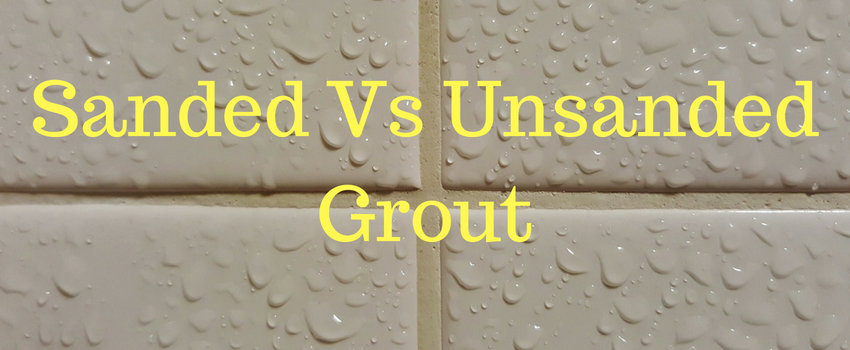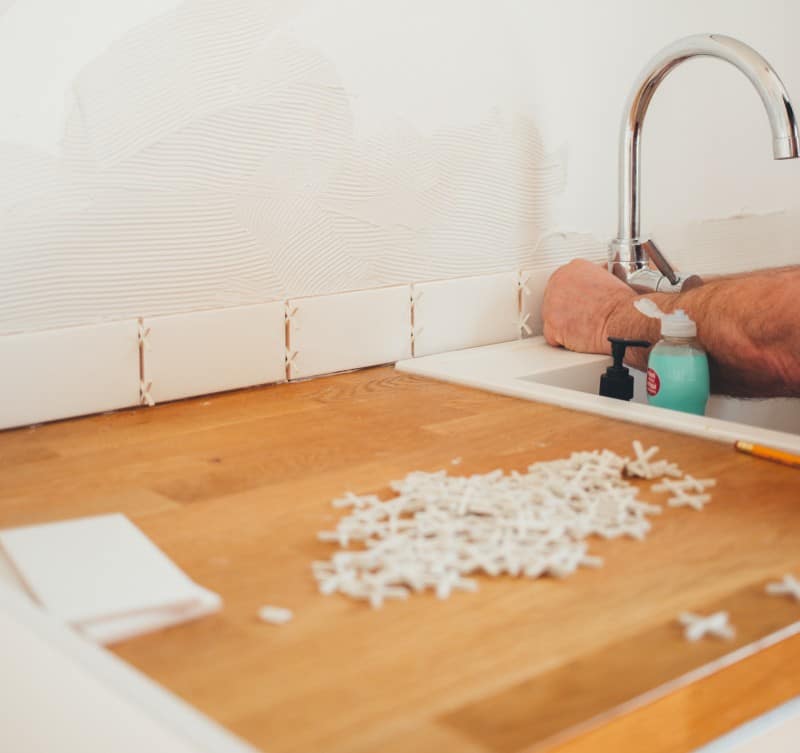You have taken the decision to do some DIY work at your home such as adding tiles to your kitchen back splash or shower enclosure, installing flooring in a room etc. Being a first-time DIYer, you are planning on having plenty of extra tile on hand in case of a redo.

However, in selecting the grout you see a difference in products. Should you pick up the sanded or the unsanded type for your project and what is the difference?
Sanded Grout
Sanded grout is the most popular choice for DIYers. It is less expensive than the unsanded type and comes in an assortment of colors. The type of tile that you plan on installing is what makes the difference in its use.
Fine sand, along with polymers, has been added to cement-based sanded grout. The sand acts as an adhesion and prevents too much shrinkage as the grout dries. It is recommended for grout lines measuring 1/8″ wide or more.
Because sand is gritty, it can only be used with tile that is not easily scratched.
Sanded Grout Use Cases:
- Any flooring project. Because this type of grout is more resistant to pressure, installing flooring surfaces with sanded grout is the way to go.
- Thick joints (in horizontal surfaces).
- There are also certain types of ceramics that are more scratch-resistant than others that can use sanded grout without causing damage.
Unsanded Grout
Unsanded grout is easy to work with on vertical surfaces and is recommended for grout lines that are less than 1/8″ wide.
It does not have the slump that is often associated with sanded grout in getting an even coverage. This is due to the pudding-type texture without the added sand.
However, sand is a cheap filler for grout and when it is absent more polymers make up the difference. The reflection in price is also substantial. Unsanded grout usually costs more than its sanded counterpart.

Unsanded Grout Use Cases:
- Certain soft tiles and materials that may be scratched such as:
- marble
- limestone
- polished or honed stone
- glass
- porcelain
- ceramic
- Narrow joints (less than 1/8″ wide).
- Vertical surfaces such as shower wall, kitchen backsplash etc.
Some Differences Between Sanded Vs Nonsanded
All grouts based on cement are of porous nature and can stain. You may find many more colors available for sanded grout than unsanded grout. This is merely a choice of the retailer to stock the most popular shades.
However, there are hundreds of shades in both grout types to choose from. Visit the manufacturer website or a DIY store for a complete list.
Price wise, sanded grout is the way to go, especially if you are a DIYer, since is cheaper and also easier to work with (if you don’t have much experience).
Grouting is a learning process and can get very costly by using unsanded grout. Also, you may want to reconsider that shiny glass back splash that you have selected for the kitchen until you are sure that you are a pro at grouting.
There are many different types of tiles that are coated to protect against scratching. This could be an option especially in a busy kitchen area.
Best Grout Type for Shower and Bathrooms
This must be waterproof and mold-resistant. Usually unsanded type is used because tiles in showers are installed very close together (narrow spacing).
Another option that we haven’t talked before is epoxy-based grout which is much stronger than other types because of its chemical composition. These are also waterproof as well.
Another option is to apply standard cement-type grout but you must also apply sealing agent on top of it.
Best Grout for Kitchen Backsplash
Again, its better to go with Unsanded option here since you will be working with vertical surfaces and joints are very close together. Moreover, some home owners select also Acrylic option (grout that is pre-mixed with Acrylic and does not need any sealing) which is great also for outdoor kitchen backsplash.
Mortar Vs Grout
Although these two materials are both used in masonry and tile work, they have different purposes.
Mortar is used as the base in order to make one material stick to another. For example, when laying wall tiles, mortar can be used to stick tiles on the wall.
Grout on the other hand is used as filler to close the gaps between joints of tiles etc.
Should I Use Sanded or Unsanded Grout in the Shower?
If you are installing grout in between your shower tiles, then unsanded grout is the better choice for several reasons.
Unsanded grout is thinner than sanded grout because it does not have sand particles, making it the better choice for thin tile joints up to one-eighth of an inch in thickness, which is the thickness that tile joints in showers tend to be.
Unsanded grout is also smoother, making it a better choice for delicate materials that scratch easily, such as marble that often makes up shower tiles. It also holds up better to vertical applications.
If you are applying grout to the shower pan, then you can use both sanded and unsanded grout.
Does Sanded Grout Need to Be Sealed?
While sanded grout does not necessarily need to be sealed to function, it can still be a good idea to apply a sealer, unless you are working with epoxy grout.
Even compact sanded grout absorbs water and bacteria over time, which affects the appearance of your surface and could cause mold to grow in between your tiles. Applying grout sealer makes your grout more durable.
To apply sealer, wait two to three days after you’ve applied grout to give it a chance to dry. Then, paint, roll, or spray on the grout according to the sealer instructions and your own preferences.
When you’re applying the sealer, avoid applying it directly to the tile as that could damage the surface.
Does Sanded Grout Scratch Tile?
Sanded grout is coarser than unsanded grout because it contains larger sand particles. This should not pose a problem for most tile materials, including ceramic and glass, although sometimes accidents happen.
Sanded grout could scratch tiles made out of softer materials such as marble or those with certain high-gloss finishes. In addition to scratching tile, it stains certain surfaces, such as tumbled or natural finish stone.
If you’re not sure if your tiles will hold up to sanded grout, perform a spot test and apply a small amount of dry grout to an extra tile before installation.
This should help you tell if it will damage the surface. If you really want to be sure, use unsanded grout instead.
When Should I Use Non-Sanded Grout?
Non-sanded, or unsanded, grout is finer and stickier than sanded grout. It also tends to be harder to apply, but there are certain cases when it is worth the extra work.
Non-sanded grout is best for tile joints that are one-eighth-inch wide or smaller, such as shower tile joints, because of its fine texture.
It is also gentler on surfaces, making it a better choice when using softer tile materials such as marble. Its smooth texture also means that it sticks better without the aid of gravity, making it a good choice for vertical applications.
You shouldn’t use non-sanded grout for floor tiles because it is less resistant to wear and tear.
Can Sanded and Unsanded Grout Be Mixed?
There are a few situations where you can mix sanded and unsanded grout. For example, adding a little unsanded grout makes sanded grout stickier, which helps when applying it to vertical surfaces.
However, you should take care when mixing. Only use two grouts of the same color, otherwise, it will create an unsightly mixture that will become an eyesore.
You should also carefully measure out how much of each type of grout you are using and record the quantities in case you need to repair the grout in the future.
To mix any type of grout, be sure to follow the manufacturer’s instructions for the right water-grouting powder ratios.
Mapei Grout Colors
Mapei is a global and popular manufacturer of grouts, sealants, caulk etc. They have hundreds of colors when selecting the above material found on their website here.
Related Posts
- Comparison of HardieBacker Cement Board vs Plywood For Tiling Projects
- 6 Great Alternatives to HardieBacker Cement Board
- Comparison of WonderBoard vs GoBoard Used as Tile Backer Boards
- How Much Does it Cost to Furnish a House – Living Room,Bedroom,Kitchen etc
- 5 Benefits of Spray Foam Insulation During Summer
- Here are Some Plumbing Installation Tips For your New Home
Leave a Reply